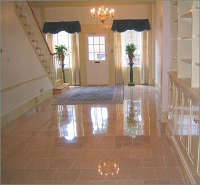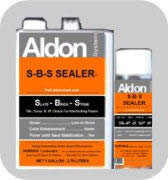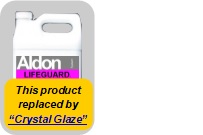
Granite Slabs & Tiles
Polished Finish(See other page for honed & flamed finishes)
How to:
Seal | Clean | Repair | Protect
Strip & Restore | Easy Care

Phone Viewing Tips:
Turning it sideways can improve viewing
Page bounce? Reload it. Different browsers can handle pages differently.
Turning it sideways can improve viewingPage bounce? Reload it. Different browsers can handle pages differently.



More granite details:
Although polished granite will bead water, there may be sufficient (invisible to the naked eye) "micro crack" separations between granite particles to allow the entrance of a highly penetrating staining liquid allowed to stand for a length of time. Once past the polished finish, these liquids are in contact with the absorbent natural stone. Phenol based cough syrup, some fruit juices, etc. have managed to do this. To deal with this type of stain situation, click here.
When you compare polished marble and limestone to polished granite, it is often difficult to tell which is which. You cannot tell by look or feel. As granite does not react with acidic liquids, cleaners are not a concern unless they can create a stain. Sealing options are below. Here is how you can do an acid test to confirm which you have. Be sure to test on the underside as acid will etch marble and limestone faces.
As you progress down this page you will see:
- The products you may need for surface Preparation before sealing.
- Pictures of each of the recommended sealers for this surface type. Click the sealer's picture for it's full description.
- Handy tips to prevent issues that others have had before coming to Aldon.
- Perhaps more information than you need now, but might be of interest later.
Surface Preparation before sealing
What you need for your Granite project
You have 1 of the 3 possible situations that follow. The products you need are listed in the sequence that you would use them. Click the picture to add a product to your list.
#1. If the Polished Granite is not yet grouted
| Use 1st | 2nd | 3rd |
|---|---|---|
 Grout Easy
|
 *Grout Residue Remover |
 *Efflorescence Treatment |
#2. If the Polished Granite is grouted, but never sealed.
| 1st | 2nd | ||
|---|---|---|---|
 *Grout Residue Remover |
 **Efflorescence Treatment |
 ***Grout Restoration |
** If you have white powder (efflorescence) stains.
*** If your grout is badly stained.
#3. If the Polished Granite has had a sealer applied in the past.
| Use 1st | 2nd | ||
|---|---|---|---|
 Premium Stripper |
 *Grout Residue Remover |
 **Grout Restoration |
** If your grout is badly stained. Regular stains are usually removed by the stripping process.
Your Choices for Sealing
But First - click here to remove the guess work about sealer results on your project:
Most people have no idea about the history and characteristics of their flooring. You can click this link to see how to easily test with water drops and understand which sealer is most appropriate for your goals.
Some questions you may not be thinking to ask right now that could become important:
. Was it sealed in the past? Does that matter?
. Will a new sealer be compatible with whatever was used before?
. What Aldon sealer will give the visual results you want?
. Will you also be able to have an Aldon sealer solve problem(s)? ( Answer: yes. Just know which to pick.)
"S-B-S Sealer" . This sealer is | Solvent Base | Penetrating Type. Provides: color enhancement | low gloss | strengthening | efflorescence barrier. Coverage guidelines (depending on absorption) 150 to 500 sq.ft./gal.

Add to Project List
|
|---|
Why only this one choice?
A polished stone finish has unique criteria that limits choices in sealing. It is usually desirable to not have an observable change to the factory polished finish.A sealer applied with an applicator tool (brush, roller) usually leaves streaks on this kind of surface. This criteria dictates the use of a sealer that can create a thin and invisible coating that will repel oil and water type liquids. And can be applied as a spray. S-B-S Sealer is the best choice for this and it also comes in aerosol cans for spraying. You can see a video of how easy a process this is here.
Add one application of "Lifeguard" for another level gloss. You can increase gloss with more applications as desired.
Easy Care Products: for a Granite floor.

_____________________
|

_____________________
|
|---|
"Maintain" - for no streak wet mopping of Granite and all other types of flooring.

_____________________
|

_____________________
|
|---|
"Dust Whiz" - easy dry mop dust pickup at 1,000 sq. ft. in 3 minutes.
Items of Interest
How to select a sealer
An Aldon sealer does far more than just bead water and look pretty! To see what that is click here.
Your results may vary somewhat from these pictures due to variations in computer display and the surface materials themselves. Nevertheless, you will be able to see the differences well enough to make good choices.
Important: If your project has had any sealer applied in the past, it must be evaluated differently. To see why, Click here!
Sealer "solids" levels?
Here are the relative solids level of our petroleum solvent based sealers:
Lowest: SBS Sealer
Next level Higher: Penetrating Paver Sealer
Another level higher: Porous Stone Sealer
Highest level: Mexiglaze
A porous surface will require more gallons (more money) of a lower solids sealer than using a higher solids level sealer. That, plus different surfaces have different requirements, is why we make the different solids levels. They all work as described, so it is only a matter of which is best for your needs.
The more porous the surface, the more solids will be required to achieve the desired effects of gloss, strengthening, stopping efflorescence, etc.
The more porous the surface, generally the greater the need for the sealer to create a stronger surface.
An old sealer below the surface, even after stripping, will lower the absorption and porosity to some degree. Sometimes it is uneven below the surface and can create an uneven coloring effect with a color enhancing sealer applied later. Another reason to test first.
To see more of why the price per gallon has little to do with what will be your total project cost, click here. For other questions about sealers, see the FAQ Sealers link on the slide out menu.
Do not believe yet that you have the type of surfacing you were told:
Do not "pre-seal" - apply a sealer BEFORE grouting.
Colors fading?
You can stop efflorescence (white powdery stains)
Efflorescence (subsurface originating white powdery stains) is common with many surfaces. This can even occur before installation. However, it is easily made to disappear without scrubbing by using Aldon Efflorescence Treatment. If the white powder is old and is now "crystalline" that is bonded to the surface - it can be eaten away with Aldon Grout Residue Remover.
Renew a glossy finish
Aldon Sealer applications can be made hours or years later, but do not apply thin layer upon thin layer. Apply a sufficient quantity to insure below surface penetration & bonding. Or, for the solvent based penetrating sealers, test spraying lacquer thinner as an alternative to slightly melt and reform the surface and not build too much gloss or create sealer "layering". A layer of sealer on top of another layer of sealer can result in poor bonding between layers and that can cause separation peeling that looks grayish.
Concerned about Doing It Yourself or what your contractor says?
If you are concerned about doing it yourself - consider that the satisfaction of a project is directly related to YOUR knowledge of what needs to be done and how. Who actually does the work is less important. We estimate that 50% of the usage of Aldon products is by "do it yourself" homeowners and we know they are happy because we hear from them.
Our goal for our contractor customers - NO CALL BACKS. A good contractor will understand the logic of Aldon application instructions on the labels and will not take shortcuts. If a contractor does not agree, feel free to let us find out what is so unusual about this particular project so the contractor does not have to return.
© Aldon Corporation All Content, Design, Copy, Code, and Graphics copyright 1995-2017 by
Aldon Corporation and protected under applicable USA and international intellectual property law.
Our goal for our contractor customers - NO CALL BACKS. A good contractor will understand the logic of Aldon application instructions on the labels and will not take shortcuts. If a contractor does not agree, feel free to let us find out what is so unusual about this particular project so the contractor does not have to return.
Aldon Corporation and protected under applicable USA and international intellectual property law.
